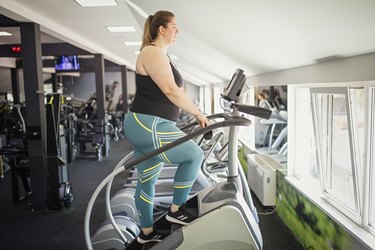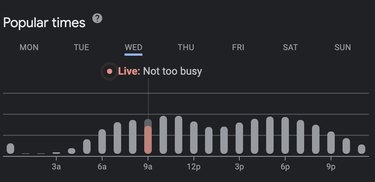
The best answer to the question, "When should I work out?" is also the simplest: whatever time works best for you. Considering around 75 percent of Americans don't meet the CDC's guidelines for aerobic and muscle-strengthening activities, most health and fitness pros aren't overly concerned with exercise timing. A consistent exercise routine — early in the morning, over your lunch break or in the evening — is a win.
However, if you have the flexibility to choose when to schedule your sweat sessions, there are some physical, mental and logistical factors worth considering. To help you determine what workout time best suits you and your goals, we looked at the research and chatted with a few experts. Here's what you need to know about the best time to work out.
Video of the Day
Video of the Day
The Benefits of Morning Workouts
If you've got a "get it done first thing" mindset, you're definitely onto something. One of the benefits of working out in the morning is that a morning routine can be easier to stick to. An August 2022 study in Current Biology suggests that after a long day of decision-making, your brain fatigues and tends to gravitate toward "low-effort actions with short-term rewards." (If you've ever skipped an evening workout to spend the night curled up on the couch, you're familiar with the concept.) Working with a "fresh" brain in the morning, you may be less tempted to bail on your date with the gym.
And if fat loss is among your health and fitness goals, the morning might be the best time to work out for weight loss. Thanks to our circadian rhythm, or inner clock, our bodies are more sensitive to insulin, the hormone that helps cells absorb glucose from the blood and use it for energy, in the earlier part of the day, explains Fabio Comana, MA, MS, lecturer at San Diego State University's School of Exercise and Nutritional Sciences.
"If you eat 20 grams of glucose, the amount of insulin your body would need to metabolize that would be less in the morning than it would in the afternoon," Comana tells LIVESTRONG.com. "What that means is you're going to have an elevated amount of insulin [in the afternoon and evening] that is also probably going to stay in circulation for a little longer."
Insulin, Comana explains, suppresses fat metabolism, so you may burn more fat when exercising in the morning than at night.
Related Reading
The Benefits of Evening Workouts
If gaining strength and improving athletic performance are your primary concerns, working out in the evening could help you tap into your full potential. A December 2020 study in Physiology suggests muscle strength tends to peak in the late afternoon, somewhere between 4 p.m. and 8 p.m. Comana suggests this is likely due, in part, to rising hormone levels and shifts in the body's joints and fascia, the layers of connective tissue that encase our muscles and other internal structures.
In the morning, after a full night of lying down, your fascia is less pliable, and your joints are less lubricated. (This is why you often feel "stiff" or "creaky" when you first step out of bed.)
"[In the morning], you're having to fight a little bit of your own internal resistance," Comana says. But as your body moves throughout the day, your tissues become more pliable, and your joints are lubricated with synovial fluid, allowing you to move more efficiently. You might find that you can move faster or lift heavier in the evenings, according to Comana.
However, for all the potential gains that come with nighttime workouts, you could lose quality sleep. Exercise —especially intense exercise — raises the body's core temperature, which can stay elevated right up until the time you go to bed.
"One important stage of sleep, stage two, is marked by a lowering of your core temperature because that actually prepares your body for restful sleep, which falls in stage three and stage four of sleep," Comana says. "If your core temperature remains elevated, you might fall asleep, but you may not be getting into the deep stages of sleep."
To make sure you're not compromising rest and recovery, Comana recommends against doing high-intensity workouts late in the evening. And if you do work out at night, a February 2019 review in Sports Medicine found exercising at a moderate intensity up until an hour before you go bed isn't likely to disrupt your sleep. But if you do exercise a little too close to bedtime at a higher intensity, a cool bath can help reduce your core temperature.
Related Reading
What About Afternoon Workouts?
If you don't have a flexible schedule or generous lunch break, mid-day workouts can be tough to schedule. But, if you can squeeze them in, research suggests some major health benefits.
A February 2023 study in Nature Communications compared the mortality of participants who performed moderate-to-vigorous intensity exercise in the morning (5 a.m. to 11 a.m.), the afternoon (11 a.m. to 5 p.m.) and the evening (5 p.m. to 12 a.m.) over seven years. Researchers found a link between afternoon exercise and a reduced risk of early death.
While an afternoon workout may not capitalize on your body's full fat-burning potential or tap into your peak strength, it may hit a "sweet spot" for overall health.
"[The research findings] make sense," Paul Arciero, PhD, professor of health and human physiological sciences at Skidmore College, tells LIVESTRONG.com. "The body's in a more homeostatic state in the afternoon. You're not just waking up, you're not transitioning from sleep to moving. Then in the evening, exercise can be very disruptive to sleep. So, if people had the ideal lifestyle and they could fit in an exercise routine between 3 p.m. and 5 p.m., that could be definitely beneficial."
The Best Time of Day to Hit the Gym
Ultimately, the answer to the question, "What is the best time of day to exercise?" is the one that works best for your schedule. So it makes sense that your environment can also affect your exercise experience and consistency, and it's important to consider your gym's own "internal clock" when scheduling your workouts. Here are a few tips to keep in mind.
1. Identify Your Ideal Gym Vibe
For every member who wants to get their workout done as quickly and efficiently as possible, there's someone who gets more satisfaction from a leisurely, two-hour workout.
If you fall into the former category, you'll want to identify your gym's least busy times, as it will be easier to navigate the facility and access equipment. This will vary from gym to gym, and if you're wondering when your gym is the least busy, you can even use Google to see if your gym will be packed at a certain time if you don't want to check it out in person.

Crowds tend to be lighter early in the morning and mid-day, and the gym-goers who do show up at these times tend to be of the same mindset, according to Pete McCall, CSCS, CPT, master trainer and host of the All About Fitness podcast.
"The early morning workout people are serious. They're not there to goof around. They're not there to be social. They're there to be serious, and so are the lunchtime people. The people at lunchtime want to get in and get out," he tells LIVESTRONG.com.
Conversely, McCall has interacted with many clients who make the gym part of their social experience by taking their time and chatting between sets.
"You're paying for your membership, so why not go there and make it a social event and hang out with your friends for a couple of hours?" he says.
Both approaches are valid. The key is to find the time of day that best aligns with your needs and expectations.
2. Avoid the Pre- and Post-Workday Gym Rush
For many people, the only time feasible time to hit the gym is right before or after work. During pre- and post-workday rushes, things like parking spots, showers, dumbbells and treadmills will be harder to access.
If you have a flexible schedule, it's best to avoid these times. If you can only get to the gym during peak hours, go in with a Plan A and a Plan B. For example, your Plan A might be to use the squat rack and run a quick mile on the treadmill. But, if the squat rack is busy and there are no open treadmills, pivot to Plan B, a lower-body dumbbell circuit and five minutes on the rower, for instance.
3. Check Your Gym's Group Fitness Schedule
Even if you don't plan to attend group fitness classes, knowing the schedule can help you avoid some of the gym's busiest times.
"In some gyms, you might have three or four studios going on at the time. You might have a yoga studio, a main studio and a cycling studio. And if they all have classes starting on the hour, then the locker room is going to be chaos a few minutes before the hour," McCall says. "You're better off timing it so you get there 10 or 15 minutes after the hour."
- CDC: "Physical Activity Among Adults Aged 18 and Over: United States, 2020"
- Current Biology: "A neuro-metabolic account of why daylong cognitive work alters the control of economic decisions"
- Physiology: "Time of Day and Muscle Strength: A Circadian Output?"
- Nature Communications: "Associations of timing of physical activity with all-cause and cause-specific mortality in a prospective cohort study"